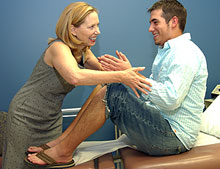This spring, Adam Tinnin, a normally healthy, active 16-year-old, experienced a viral infection that caused mouth sores, hives, then tingling and numbness in his feet. In a matter of days, he couldn’t walk.

Adam and his mother, Stephanie, came to Washington University Medical Center from their home in Sikeston, Mo., to see specialists about his condition. He spent three weeks at St. Louis Children’s Hospital and went through dozens of tests, which all showed normal results. Adam, frustrated and distressed, was preparing to return to Sikeston, worried that he might spend the rest of his life in a wheelchair.
“I felt like giving up,” Adam said. “I felt that all hope was gone and that I would probably deal with this until somebody knew what was going on.”
Susan Mackinnon, M.D., the Sydney M. Jr. and Robert H. Shoenberg Professor of Surgery and chief of the Division of Plastic and Reconstructive Surgery, happened to be having lunch in the doctor’s lounge at the hospital on a day when Adam’s case was being discussed. Mackinnon’s interest was piqued, and she asked if she could examine Adam. After the examination, Mackinnon was confident she knew what Adam’s trouble was — a viral neuropathy with tarsal tunnel syndrome, similar to carpal tunnel syndrome, but in the ankles.
“While tarsal tunnel syndrome is not a rare condition, it is very rare that it becomes so severe that a patient can’t walk, especially in someone so young,” Mackinnon said.
Tarsal tunnel syndrome, which can be difficult to diagnose, is caused by pressure on the tibial nerve, which follows a long route down the back of the leg to the ankle, where it turns and curls below the inside of the ankle. Sometimes ligaments and other tissues that surround the nerve press on it, causing pain, a burning sensation and tingling on the sole of the foot. In Adam’s case, it also prevented him from walking.
Mackinnon performed tarsal tunnel release surgery on Adam’s left foot May 1. During the one-hour procedure, she cut the covering over the tibial nerve to relieve the pressure. Everyone has some covering over the nerve, but Adam’s was very thick. By the time he had the surgery on his right foot June 9, he had feeling back in his left foot and was able to drive and walk with crutches. The severe pain in his left foot was gone.
By late June, Adam had feeling back in his toes and could walk without assistance. About a month after the second surgery, he returned to his job at UPS and was back to being a normal, healthy teenager.
Adam is now looking forward to starting his junior year of high school and using the experience to fuel his drive to become a physician — with strong leanings toward anesthesiology or plastic surgery. He would also like to attend Washington University as an undergraduate.
“I took for granted what I had before, but when everything was swept out from underneath me I knew then that anything can be taken away from us,” Adam said. “I believe Dr. Mackinnon was sent by God into my room that day and I know I will never forget her.”